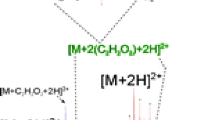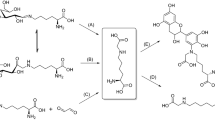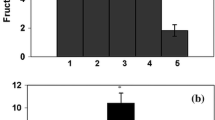Summary
L-Arginine (Arg) has a structure similar to that of aminoguanidine (AG) and may inhibit glycation and advanced glycosylated end product (AGE) formation. Human serum albumin (HSA) (100mg/ml) was incubated for 2 weeks with glucose (200mM) at 37°C or with glucose and equimolar concentrations of Arg, N-α-acetyl Arg, or AG with or without 25mM diethylenetriaminepentaacetic acid (DTPA). In the absence of DTPA, electrospray ionization mass spectrometry showed a 70% reduction of covalently bound glucose in the presence of Arg and a 30% reduction with AG. Digestibility by trypsin of HSA incubated with glucose and Arg was similar to that of HSA incubated alone. This suggests less covalent modification of HSA in the presence of Arg as compared with the absence of Arg. When incubations contained DTPA, autoradiography showed less14C labeling of HSA subunits in the presence of Arg and AG. When theα-amino group of Arg was blocked with an acetyl group, labeling was similar to that of HSA incubated with glucose, suggesting involvement of theα-amino group in the inhibition. Fluorescence of HSA at ex370 and em440 was reduced with Arg, but AG was more effective than Arg. These results suggest that Arg, like AG, can inhibit glycation and AGE formation.
Similar content being viewed by others
References
Baynes JW, Thorpe SR, Murtiashaw MH (1984) Nonenzymatic glucosylation of lysine residues. Methods Enzymol 106: 88–98
Bradford M (1976) A rapid and sensitive method for the quantitation of microgram quantities of protein utilizing the principal of protein-dye binding. Anal Biochem 72: 248–254
Brownlee M, Vlassara H, Cerami A (1984) Nonenzymatic glycosylation and the pathogenesis of diabetic complications. Ann Intern Med 101: 527–537
Brownlee M, Vlassara H, Kooney A, Ulrich P, Cerami A (1986) Aminoguanidine prevents diabetes-induced arterial wall protein cross-linking. Science 232: 1629–1632
Brownlee M, Cerami A, Vlassara H (1988) Advanced glycosylation end products in tissue and the biochemical basis of diabetic complications. N Engl J Med 318: 1315–1321
Brownlee M, Cerami A, Vlassara H (1988) Advanced products of nonenzymaticglycosylation and the pathogenesis of diabetic vascular disease. Diab Metab Rev 4: 437–451
Dyer DG, Blackledge JA, Katz BM, Hull CJ, Adkisson HD, Thorpe SR, Lyons TJ, Baynes JW (1991) The Maillard reaction in vivo. Z Ernährungswiss 30: 29–45
Edelstein D, Brownlee M (1992) Mechanistic studies of advanced glycosylation end product inhibition by aminoguanidine. Diabetes 41: 26–29
Fu MX, Knecht KJ, Thorpe SR, Baynes JW (1992) Role of oxygen in cross-linking and chemical modification of collagen by glucose. Diabetes 41 [Suppl] 2: 42–48
Fu MX, Wells-Knecht KJ, Blackledge JA, Lyons TJ, Thorpe SR, Baynes JW (1994) Glycation, glycoxidation, and cross-linking of collagen by glucose: kinetics, mechanisms, and inhibition of late stages of the Maillard reaction. Diabetes 43: 676–683
Hunt JV, Dean RT, Wolff SP (1988) Hydroxyl radical production and autoxidative glycosylation. Biochem J 256: 205–212
Hunt JV, Bottoms MA, Mitchinson MJ (1993) Oxidative alterations in the experimental glycation model of diabetes mellitus are due to protein-glucose adduct oxidation. Biochem J 291: 529–535
Igaki N, Sakai M, Hata H, Oimomi M, Baba S, Kato H (1990) Effects of 3-deoxyglucosone on the Maillard reaction. Clin Chem 36: 631–634
Kato H, Shin DB, Hayase F (1987) 3-Deoxyglucosone crosslinks proteins under physiological conditions. Agric Biol Chem 51: 2009–2011
Laemmli UK (1970) Cleavage of structural protein during assembly of the head of bacteriophage. Nature 227: 680–685
Ledl F (1991) Der Abbau von reduzierenden Zuckern und Aminen bei der Maillard-Reaktion. Z Ernährungswiss 30: 4–17
Ledl F, Schleicher E (1990) New aspects of the Maillard reaction in foods and in the human body. Angewandte Chemie 29: 565–594
Lubec G, Vierhapper H, Bailey AJ, Damjancic P, Fasching P, Sims TJ, Kampel D, Popow C, Bartosch B (1991) Influence ofL-arginine on glucose mediated colagen cross link precursors in patients with diabetes mellitus. Amino Acids 1: 73–80
Means GE, Feeney RE (eds) (1971) Chemical modification of proteins. Holden-Day, San Francisco, pp 194–211
Menzel EJ, Reihsner R (1991) Alterations of biochemical and biomechanical properties of rat tail tendons caused by non-enzymatic glycation and their inhibition by dibasic amino acids arginine and lysine. Diabetologia 34: 12–16
Mereish KA, Rosenberg H, Cobby J (1982) Glucosylated albumin and its influence on salicylate binding. J Pharm Sci 71: 235–238
Morris MA, Preddy L (1986) Glycosylation accelerates albumin degradation in normal and diabetic dogs. Biochem Med Metab Biol 35: 267–270
Ramakrishnan S, Sulochana KN (1993) Decrease in glycation of lens proteins by lysine and glycine by scavenging of glucose and possible mitigation of cataractogenesis. Exp Eye Res 57: 623–628
Sensi M, De Rossi MG, Celi FS, Cristina A, Rosati C, Prrett D, Anreani D, Di Mario U (1993) D-Lysine reduces the non-enzymatic glycation of proteins in experimental diabetes mellitus in rats. Diabetologia 36: 797–801
Shin DB, Hayase F, Kato H (1988) Polymerization of proteins caused by reaction with sugars and the formation of 3-deoxyglucosone under physiological conditions. Agric Biol Chem 52: 1451–1458
Smith RD, Loo JA, Edmonds CG, Barinaga CJ, Udseth HR (1990) New developments in biochemical mass spectrometry: electrospray ionization. Anal Chem 62: 882–899
Smoyer WE, Brouhard BH, Rassin DK, LaGrone L (1991) Enhanced GFR response to oral versus intravenous arginine administration in normal adults. J Lab Clin Med 118: 166–175
Sokal RR, Rolf JF (1981) Linear regression. Biometry, 2nd edn. WH Freeman and Co, New York, pp 454–530
Soulis-Liparota T, Cooper M, Papazoglou D, Clarke B, Jerums G (1991) Retardation by aminoguanidine of development of albuminuria, mesangial expansion, and tissue fluorescence in streptozocin-induced diabetic rat. Diabetes 40: 1328–1334
Van Boekel MAM (1991) The role of glycation in aging and diabetes mellitus. Mol Biol Rep 15: 57–64
Vidal P, Nielsen E, Welinder BS (1992) Effect of glycation on the heterogeneity of human serum albumin analysed by reversed-phase high-performance liquid chromatography in a solvent containing formic acid. J Chromatogr 573: 201–206
Wells-Knecht KJ, Zyzak DV, Litchfield JE, Thorpe SR, Baynes JW (1995) Mechanism of autoxidative glycosylation: identification of glyoxal and arabinose as intermediates in the autoxidative modification of proteins by glucose. Biochemistry 34: 3702–3708
Weninger M, Zhou X, Lubec B, Szalay S, Höger H, Lubec G (1992)L-Arginine reduces glomerular basement membrane collagen Nε-carboxymethyllysine in the diabetic db/db mouse. Nephron 62: 80–83
Wolff SP, Dean RT (1987) Glucose autoxidation and protein modification. Biochem J 245: 243–250
Wolff SP, Jiang ZY, Hunt JV (1991) Protein glycation and oxidative stress in diabetes mellitus and ageing. Free Radical Biol Med 10: 339–352
Zyzak DV, Richardson JM, Thorpe SR, Baynes JW (1995) Formation of reactive intermediates from Amadori compounds under physiological conditions. Arch Biochem Biophys 316: 547–554
Author information
Authors and Affiliations
Additional information
Presented in part at the FASEB meeting, Atlanta, GA, 1991.
Rights and permissions
About this article
Cite this article
Servetnick, D.A., Bryant, D., Wells-Knecht, K.J. et al. L-Arginine inhibits in vitro nonenzymatic glycation and advanced glycosylated end product formation of human serum albumin. Amino Acids 11, 69–81 (1996). https://doi.org/10.1007/BF00805722
Accepted:
Issue Date:
DOI: https://doi.org/10.1007/BF00805722




